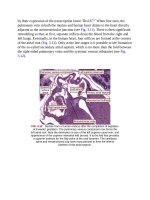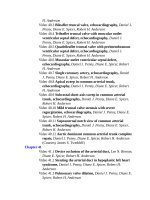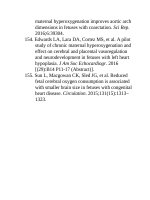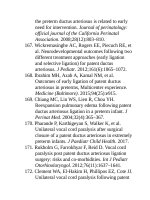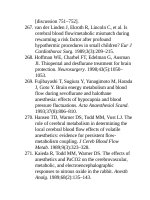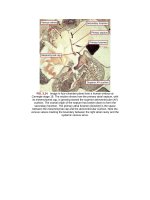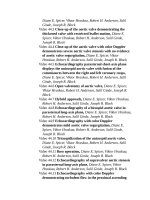Andersons pediatric cardiology 1124
Bạn đang xem bản rút gọn của tài liệu. Xem và tải ngay bản đầy đủ của tài liệu tại đây (144.53 KB, 3 trang )
FIG.42.31 Rightventricularangiogramintheanteroposteriorandlateral
projectiondemonstratingthedomedandstenosedpulmonaryvalve(top)
andallowingmeasurementoftheventriculoarterialjunction(bottom).
FIG.42.32 Rotationalangiographywiththree-dimensionalreconstruction
inapatientwithpulmonaryvalvestenosisandassociatedstenosisofthe
leftpulmonaryartery.
Onceangiographyhasbeenobtained,theangiographiccatheteriswithdrawn
andanend-holecatheterutilizedtocrossthevalve.Itisimportanttocrossthe
tricuspidvalveinafashiontointubatethemajorapertureofthevalveratherthan
allowingthecathetertopassbetweentendinouscords,sincethelattercancause
avulsionofthetricuspidvalvewhenthedenaturedballooncatheteriswithdrawn
afterthedilationprocedure.88Withend-holecatheters,thiscanbestbe
accomplishedbycatchingthetipofthecatheterinthehepaticveinorrightatrial
walltocreateacurveinthetipofthecatheter.Thetricuspidvalvecanbe
crossedwiththecurvedtipbyrotatingleftwardandanteriorlyfromapositionin
therightatrium.Alternatively,aballoon-tippedcatheterismorelikelytoenter
throughthecentrallumenofthevalve,eventhoughsuchacatheteristechnically
morechallengingtodirecttowardthepulmonaryvalveinsmallerpatients.The
catheterispositionedintoeithertheleft-orright-lower-lobebranchpulmonary
arteryeventhoughtheleft-lower-lobebranchpulmonaryarteryusuallyprovides
anincreaseddegreeofstabilitytothecatheterandwire.Inneonates,advancing
thecatheter/wirethroughthearterialductintothedescendingaortacanfurther
enhancethestabilityneededtoadvanceaballooncatheteracrossthevalve(Fig.
42.33;Video42.5).89Ifneeded,gentlemanualpressurecanbeusedoverthe
inguinalregiontofixthetipofthewirewhileadvancingtheballoon.
